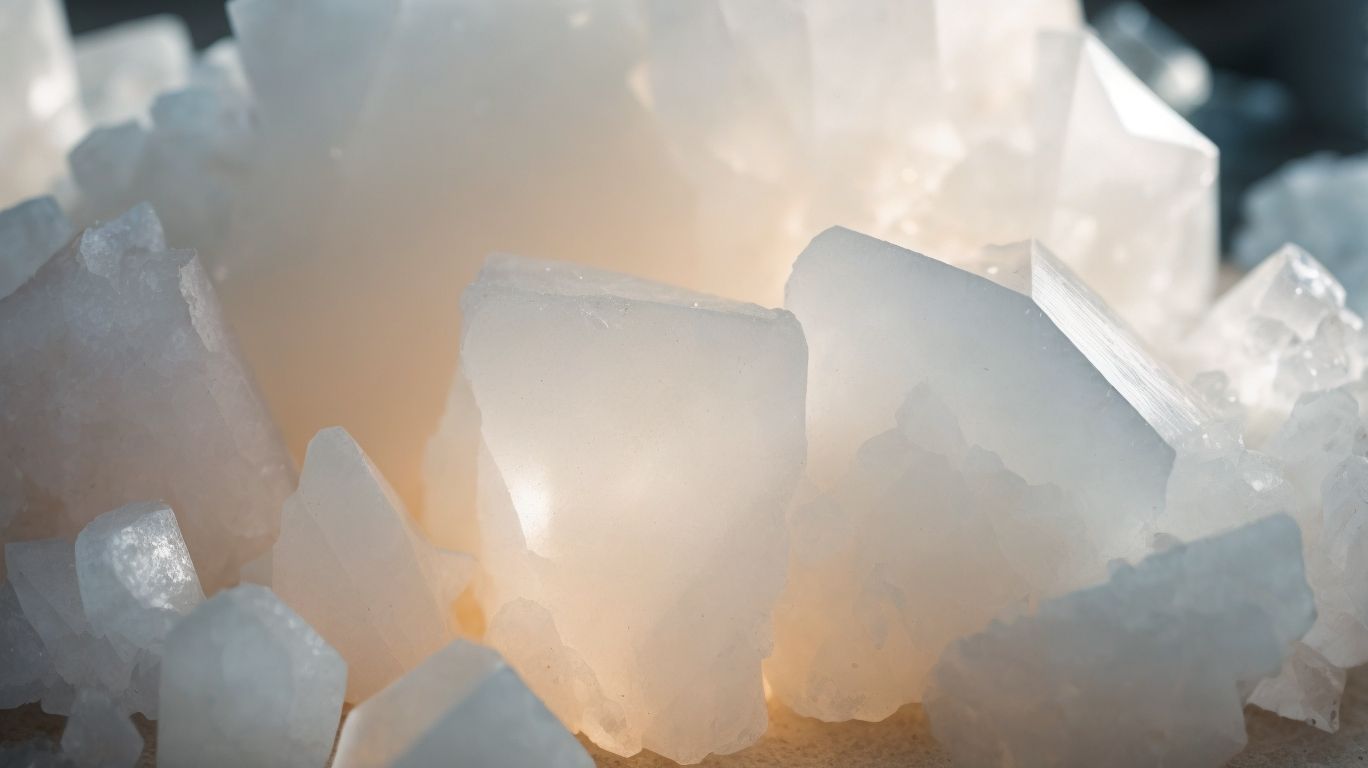
Calcite’s Soft Glow: Revealing the Charm of White Calcite Crystal
Calcite, with its soft glow and myriad of physical properties, has captivated the curiosity of mineral enthusiasts, scientists, and industry professionals alike. In this comprehensive guide, we will delve into the fascinating world of calcite, exploring its crystal structure, hardness, color, and luster. We will uncover the diverse uses of calcite in construction, agriculture, and medicine, shedding light on its invaluable contributions to various fields.
We will unravel the mesmerizing phenomenon of calcite’s glow, unraveling the science behind its fluorescence and phosphorescence. We will differentiate between various types of calcite, comparing white calcite with orange calcite and distinguishing calcite from aragonite. Join us on this illuminating journey as we uncover the charm and allure of the captivating white calcite crystal.
What Is Calcite?
Calcite, a mineral known for its soft glow when exposed to natural light, is a key component in various geological formations and crystal structures.
Its unique optical properties make it an essential mineral in the formation of stalactites, stalagmites, and the impressive display of colors in caves. As a crystal, calcite has been used for centuries in various cultural and spiritual practices due to its ability to amplify energy and enhance mental clarity. Geologically, it plays a crucial role in the formation of limestone and marble, contributing to the beauty and diversity of our planet’s landscapes.
What Are the Physical Properties of Calcite?
The physical properties of calcite encompass its unique optical properties, intricate crystal structure, cleavage tendencies, and its remarkable transparency.
What Is the Crystal Structure of Calcite?
The crystal structure of calcite is formed through intricate processes, resulting in distinct crystal growth patterns and unique formations.
Calcite crystals develop as a result of the precipitation of calcium carbonate from solutions, leading to the formation of intricate and symmetric crystal structures. The growth of these crystals is influenced by factors such as temperature, pressure, and the presence of impurities, which contribute to the varied formations observed in natural calcite specimens.
The internal structure of calcite crystals often exhibits fascinating characteristics, reflecting the environmental conditions during their formation.
What Is the Hardness of Calcite?
The hardness of calcite, along with its characteristic fracture patterns and specific gravity, contributes to its overall physical properties.
Calcite is known for its relatively low to medium hardness, typically ranking around 3 on the Mohs scale. It exhibits a perfect rhombohedral cleavage, meaning it breaks along distinct planes, often producing rhombic fragments. Calcite has a specific gravity of 2.71, which is an important factor in distinguishing it from other minerals. These physical traits make calcite a valuable mineral in various industries, including construction, agriculture, and manufacturing.
What Is the Color of Calcite?
Calcite exhibits a range of colors, often presenting as translucent and featuring variations that contribute to its appeal as a mineral, making it a sought-after choice in white gemstones.
The diverse color variations of calcite, including white, cream, yellow, and even reddish tones, add to its allure and make it a versatile gemstone option. Its translucent nature allows light to pass through, giving it a captivating and radiant glow. This makes calcite an ideal choice for jewelry, as it can enhance the overall aesthetic and appeal.
Its color and translucency also play a significant role in making it a popular choice for decorative and ornamental purposes, offering a timeless and elegant touch to various designs.
What Is the Luster of Calcite?
The luster of calcite, especially in optical calcite varieties, adds to its appeal and contributes to its use in decorative objects and other applications.
This unique luster is highly valued in the creation of jewelry, ornamental carvings, and architectural elements. The optical calcite’s ability to exhibit double refraction enhances its allure and makes it a sought-after material for decorative items. Its captivating play of light makes it an ideal choice for incorporating aesthetic and functional elements in interior design, adding a touch of sophistication and elegance to various spaces.
What Are the Uses of Calcite?
Calcite serves diverse purposes, finding applications in construction, agriculture, medicine, and even as inclusions in other minerals, expanding its utility across various fields.
What Is the Use of Calcite in Construction?
Calcite plays a vital role in construction due to its presence in formations, caves, and deposits, contributing to the development of durable and resilient construction materials.
Its crystalline structure and abundance in limestone formations make it a key ingredient in the production of cement, providing strength and durability to concrete. When calcite is finely ground, it can be used as a filler in asphalt mixtures, enhancing the stability and longevity of roads and pavements.
Its presence in natural formations and its ability to be extracted and processed for construction purposes make calcite an indispensable resource in the building industry.
What Is the Use of Calcite in Agriculture?
Calcite finds application in agriculture through its presence in veins and inclusions in quartz, contributing essential properties that benefit soil and crop cultivation.
These calcite deposits play a crucial role in regulating the pH levels of soil, thereby optimizing nutrient availability for plant growth. The presence of calcite aids in improving soil structure, promoting better water retention and drainage. This, in turn, enhances the overall quality of the soil, fostering healthier and more robust crop yields.
Calcite’s ability to neutralize acidic soils helps in creating a more favorable environment for various agricultural crops, ultimately supporting sustainable and productive farming practices.
What Is the Use of Calcite in Medicine?
Calcite’s healing properties have led to its use in medicine, while its decorative applications extend its relevance beyond medicinal uses, contributing to its versatile utility.
The healing properties of calcite are attributed to its ability to clear energies and alleviate emotional stress. In alternative medicine, it is believed to boost the immune system and alleviate symptoms of various conditions. Beyond its medicinal uses, calcite is also prized for its decorative applications, adorning homes and spaces with its beautiful, translucent colors and patterns. Its versatility makes it a valuable addition to both traditional healing practices and interior design, showcasing the dual nature of this fascinating mineral.
How Does Calcite Glow?
The glow exhibited by calcite, attributed to its fluorescent and luminescent properties, enhances the allure of calcite formations, contributing to their unique charm and appeal.
What Causes the Glow in Calcite?
The glow in calcite is a result of intricate geological processes and the presence of specific deposits, creating a soft appearance and revealing its unique optical properties.
Calcite’s fluorescence is caused by the presence of trace elements like manganese, lead, or other impurities within its crystal structure. These impurities can alter the crystal lattice and influence how the mineral absorbs and emits light, resulting in its distinctive glow when exposed to UV light.
The formation of calcite deposits is linked to various geological processes such as hydrothermal activity, metamorphism, and sedimentation, all of which contribute to its widespread occurrence in different geological settings. Understanding these processes is crucial for both geological studies and practical applications in fields like mineralogy and environmental science.
What Is the Difference Between Fluorescence and Phosphorescence?
Understanding the distinction between fluorescence and phosphorescence is crucial to comprehend the optical properties exhibited by calcite, shedding light on its captivating glow.
Fluorescence refers to the near-instantaneous emission of light by a substance when it absorbs light or electromagnetic radiation, while phosphorescence involves a delayed emission of light following the removal of the excitation source. The difference lies in the duration of the light emission.
Both phenomena play a significant role in the optical qualities of calcite, contributing to its remarkable luminous display. These optical properties are of immense interest to scientists and enthusiasts alike, offering insight into the fascinating interplay between minerals and light.
What Are the Different Types of Calcite?
Calcite manifests in various types and forms, encompassing distinct varieties and associations with carbonate minerals and metamorphic rocks, contributing to its diverse range.
What Is the Difference Between White Calcite and Orange Calcite?
The difference between white calcite and orange calcite lies in their distinct crystal formations and associations, leading to variations in their appearance and metaphysical properties.
White calcite typically forms in rhombohedral or tabular crystals, often exhibiting a translucent to opaque milky white color. It is commonly associated with purity, cleansing, and amplifying energies.
In contrast, orange calcite is known for its trigonal crystal structure and vibrant orange hue, evoking feelings of creativity, energy, and vitality. Its associations with the sacral chakra make it popular for stimulating and balancing emotions and enhancing one’s zest for life.
What Is the Difference Between Calcite and Aragonite?
Distinguishing between calcite and aragonite is essential to comprehend their unique compositions and characteristics, highlighting their distinct attributes in the realm of carbonate minerals.
Calcite and aragonite both belong to the carbonate mineral group, with calcite being a polymorph of calcium carbonate and aragonite being its less stable form. Calcite is often found in sedimentary and metamorphic rocks, while aragonite is commonly found in the shells of marine organisms.
In terms of crystal structure, calcite exhibits a trigonal crystal system, while aragonite features an orthorhombic crystal structure. These differences in composition and crystal structure result in distinct physical properties and applications of calcite and aragonite in various fields.




No Comments